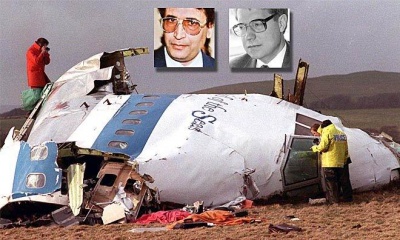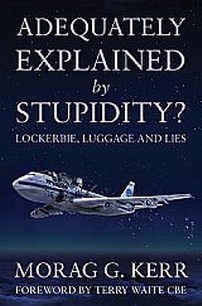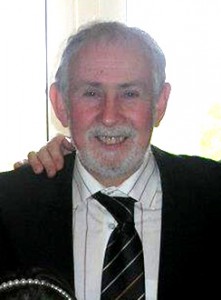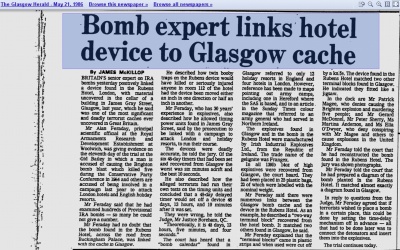Alan Feraday
Alan or Allen Feraday (born 23 December 1937) joined the Forensic Explosives Laboratory (FEL) at Woolwich in 1971. The FEL relocated in 1985 to the Royal Armaments Research and Development Establishment (RARDE) at Fort Halstead in Kent, where Feraday was a Higher Scientific Officer.[1]
Margaret Thatcher took an interest in Alan Feraday after the exculpatory testimony he gave at the "Death on the Rock" inquest in Gibraltar, when the SAS were alleged to have been operating a "shoot to kill" policy against three IRA bombers killed in March 1988.[2] Thus, in the 1989 Queen's Birthday Honours list, Feraday was awarded an OBE.
Alan Feraday was appointed head of RARDE's Forensic Explosives Laboratory when its director, Dr Thomas Hayes, retired to become a chiropodist in the latter part of 1989. Six years later, RARDE was reorganised into the less regal-sounding Defence Evaluation and Research Agency (DERA), and ceased to exist. Feraday capped his 25 years working at the FEL and retired with it, but his legacy of convincing judges in at least three cases prior to Lockerbie, that any scrap of that newfangled electronics could be proven to show terrorist intent, would continue unravelling for at least a decade more. Taken as indisputable science, his voodoo informed the legal realities created in all three cases (Danny McNamee, John Berry and Hassan Assali). Men who would later be found innocent were made guilty.[3]
In October 2013, Alan Feraday was called a liar by Steven Raeburn, editor of Scots Law magazine The Firm, in a devastating criticism of Morag Kerr's book entitled "Adequately Explained by Stupidity?" about the Lockerbie bombing:
- "Dangerous, suspicious Government-fed propaganda, based on the discredited Feraday/Hayes lies. Beware."[4]
Contents
Expert witness
Alan Feraday has appeared as an expert witness at criminal trials leading to convictions in at least six high-profile cases, three of which were subsequently overturned on appeal.[5]
Feraday's involvement in a number of other criminal cases was the subject of a parliamentary question in 1996.[6]
In September 2009, human rights lawyer Gareth Peirce wrote:
- This isn’t the first time we have heard of Hayes and Feraday. Among the many wrongful convictions in the 1970s for which RARDE scientists were responsible, Hayes played his part in the most notorious of all, endorsing the finding of an explosive trace that was never there, and speculating that a piece of chalk mentioned to the police by Vincent Maguire, aged 16, and a candle by Patrick Maguire, aged 13, ‘fitted the description better’ of a stick of gelignite wrapped in white paper. Both were convicted and imprisoned on this evidence, together with their parents and their uncle Giuseppe Conlon, who was to die in prison. All were later found to be innocent.
- Although Feraday was often addressed by the prosecution as ‘Dr’ or ‘Professor’ when he gave evidence, he had no relevant academic qualifications, only a higher national certificate in physics and electronics some 30 years old. Dr Michael Scott, whose evidence has been preferred in appeals to that of Feraday, commented that:
"The British government employed hundreds of people who were extraordinarily well qualified in the areas of radio communication and electronics. Alan Feraday is not qualified yet they use him. I have to ask the question, why?"
- Alan Feraday, like his US counterpart Thomas Thurman, has now been banned from future appearances as an expert witness, but he had already provided the key evidence in a roll-call of convictions of the innocent. A note of a pre-trial conference with counsel prosecuting Danny McNamee (who was wrongly convicted of involvement in a bombing in Hyde Park) provides a typical instance:
"F [Feraday] prepared to say it [a circuit board] purely for bombing purposes, no innocent purpose."
- The implication here was that anyone who had involvement with this circuit board would have knowingly been involved in bomb construction. That, in common with many other assertions made by Feraday, was entirely false, but it resulted in McNamee’s imprisonment for 11 years.
- To discover that al-Megrahi’s conviction was in large part based on the evidence of scientists whose value as professional witnesses had been permanently and publicly demolished ten years before his trial is astounding. The discovery nearly two decades ago of a large number of wrongful convictions enabled by scientific evidence rightly led to demands that the community of forensic scientists change its ways.[7]
Caddy Inquiry
On 17 December 1996, the House of Commons debated the Caddy Inquiry into the Forensic Explosives Laboratory at Fort Halstead.
- Mr Kevin McNamara (Kingston upon Hull, North): The whole House will be indebted to Professor Caddy for his report. He is a distinguished forensic scientist (Director of the Forensic Science Institute at Strathclyde University).
- The Home Secretary said that he saw no grounds for referring cases to the Court of Appeal, but he appeared to anticipate that, when legal representatives of convicted people obtain copies of the report, they might seek to go to the Court of Appeal again on the basis of what is in the report. First, as many hon. Members have not had an opportunity to examine the report, will the Home Secretary tell the House why he feels that those people may seek to go to the Court of Appeal again?
- Secondly, he will recall that, in a recent case, a senior official in the forensic science service (Mr Alan Feraday) was highly criticised for his lack of qualifications by, I believe, the Lord Chief Justice on appeal. Is that person involved in any of those cases?
- Home Secretary Michael Howard: The hon. Gentleman was reading rather too much into my remarks. As I said, I do not believe that any grounds arising out of this report would justify any of the cases concerned being referred to the Court of Appeal.
- However, I have learnt over a long period not to underestimate the ingenuity of lawyers. I said that it was open to representatives of those involved in those cases to make further representations suggesting that the cases should be referred, and that any such representations would be considered.
- I do not have available a specific answer to the last part of the hon. Gentleman's question. I have no reason to suppose that the person to whom he referred (Mr Alan Feraday) was involved, but perhaps I can write to the hon. Gentleman on that matter.[8]
Danny McNamee
Alan Feraday was the Crown's main scientific witness in the Danny McNamee case concerning a terrorist bomb explosion in London's Hyde Park on 20 July 1982, which killed four members of the Household Cavalry - the Queen's official bodyguard - and seven of the regiment's horses. The case against McNamee was based on the following assertions:
- Feraday testified that a fragment of printed circuit board said to have been recovered on the crime scene - but which had not been forensically tested for explosive residues - had been specifically designed to trigger a radio-controlled bomb.
- Feraday also testified that the circuit was identical to circuits recovered from an IRA cache where fingerprints of McNamee had been found on a battery.
- Finally, Feraday testified that those circuits had been built by the same person.
In 1987, Danny McNamee was sentenced to 25 years for the Hyde Park bombing despite pleading that he was innocent of the crime.
In McNamee's appeal, scientists far more qualified than Feraday exposed all three claims as utter nonsense. There was nothing specific about the circuit and it was very different in design and quality than the ones recovered at the cache. In fact, Danny McNamee had a degree in electrical engineering and would have done a much better job. The presence of his fingerprints on a battery was easily explained: he had worked in an electrical store owned by an IRA member.[9]
By 1998 Danny McNamee had spent 11 years wrongfully imprisoned and, shortly after his release under the Good Friday Agreement, a judge overturned his conviction, deeming it "unsafe" because of withheld fingerprint evidence that implicated other bomb-makers.[10]
John Anthony Downey
In what looks like an obvious attempt by the establishment to rehabilitate Alan Feraday's fatally damaged reputation, senior Sinn Fein member John Anthony Downey has now been charged over the 1982 IRA Hyde Park bombing in London. Downey has denied all charges at his Old Bailey trial.[11]
John Downey, aged 61, from County Donegal was arrested at Gatwick Airport on 19 May 2013 and appeared at Westminster Magistrates' Court on 22 May 2013 charged with the murder of four Household Cavalry members who were killed en route to Buckingham Palace. Downey's case was sent to the Old Bailey for a bail hearing on 24 May 2013 and a preliminary hearing on 5 June 2013.[12]
John Downey's arrest provoked a strong reaction from Sinn Fein who called for his immediate release. Sinn Féin Assembly member Gerry Kelly said Sinn Féin member Downey was a "long-time supporter of the Peace Process" and should be released. Gerry Kelly added:
- "The decision to arrest and charge him in relation to IRA activities in the early 1980s is vindictive, unnecessary and unhelpful. It will cause anger within the republican community. Clearly, if John Downey had been arrested and convicted previously he would have been released under the terms of the Good Friday Agreement. As part of the Weston Park negotiation, the British Government committed to resolving the position of OTRs [‘On the Runs’]. John Downey received a letter from the NIO in 2007 stating that he was not wanted by the PSNI or any British police force. Despite travelling to England on many occasions, now – six years on – he finds himself before the courts on these historic charges. This development represents bad faith and a departure from what was previously agreed by both governments. John Downey needs to be released and allowed to return home to his family."[13]
John Downey was granted conditional bail on 2 August 2013 to attend trial at the Old Bailey on 14 January 2014, where he will be represented by Gareth Peirce who famously represented those wrongly accused of the Guildford Four bombing.[14] If he has the temerity to appear as an expert witness at Downey's trial, Alan Feraday OBE should expect to face a withering cross-examination by Gareth Peirce.[15]
John Berry
Another case in which Feraday appeared as an expert witness was the 1983 prosecution of businessman John Berry, who was convicted of terrorism conspiracy charges. At the trial, Feraday testified that the timers Berry had sold in the Middle East had been designed specifically for terrorist purposes. Berry spent ten years in jail before his conviction was overturned in September 1993, when four highly qualified witnesses ridiculed the evidence that Feraday had given at the trial.
Commenting on the case, Lord Justice Taylor declared that the nature of Feraday's evidence was "dogmatic in the extreme" and that in future he should not be allowed to present himself as an expert in the field of electronics. In a recent development, the Home Office has agreed to pay compensation from the public purse to Berry because he was jailed on the erroneous evidence of Feraday.[16]
Brighton hotel bombing
The Brighton hotel bombing occurred on 12 October 1984 at the Grand Hotel in Brighton. A long-delay time bomb was planted in the hotel by Provisional Irish Republican Army (IRA) member Patrick Magee, with the intention of assassinating Prime Minister Margaret Thatcher and her cabinet, who were staying at the hotel for the Conservative Party conference. Although Thatcher narrowly escaped injury, five people were killed (including two senior members of the Conservative Party) and 31 were injured. Giving evidence at the Brighton bombing trial in May 1986, Alan Feraday said that he had examined hundreds of Provisional IRA bombs - so many he could not give a number. "The devices were deadly accurate," Feraday told the jury. "Of the six 48-day timers that had been set and recovered from Glasgow the worst was six minutes adrift and the best 10 seconds."[17]
Patrick Magee was convicted of the Brighton bombing, sentenced in September 1986 and received seven life sentences. Magee was released from prison in 1999, having served 14 years in prison, under the terms of the Good Friday Agreement.[18]
Hassan Assali
Libyan national, Hassan Assali, came to Britain in 1965. In 1985, Assali was convicted of constructing electronic timers in contravention of the 1883 Explosives Substances Act on the basis of Feraday's testimony that the timing devices were designed specifically for the triggering of IEDs. Assali's appeal against conviction was rejected in 1986. He applied to the Criminal Cases Review Commission in 1998 to review his case and, following a second appeal when other electronics experts disputed the trial evidence given by Feraday, Assali's conviction was quashed in 2005.[19]
Gibraltar shootings
On 7 March 1988, three members of an IRA active service unit were shot dead by the SAS on Gibraltar. They were reported to have planted a 500lb car bomb near the British Governor's residence. It was primed to go off the following day during a changing of the guard ceremony, popular with tourists. The three - two men and a woman - were shot as they walked towards the border with Spain. Security officers say they were acting suspiciously and the officers who carried out the shootings believed their lives were in danger. The three dead were named as Daniel McCann, 30, and Sean Savage, 24, both known IRA activists and Mairead Farrell, 31, the most senior member of the gang who had served 10 years for her part in the bombing of a hotel outside Belfast in 1976.[20]
In his 1991 book, David Leppard wrote that "Feraday first came to public notice during the inquest in Gibraltar into the deaths of three unarmed IRA terrorists gunned down by soldiers from the Special Air Services (SAS)." It was a controversial action the SAS explained by each of the three reaching for their pockets or purse, presumably to detonate a car bomb they feared might exist nearby. There were no detonators, no bomb, no other weapons. Just dead IRA members, murdered, some said. Leppard explained the role of Feraday’s testimony at the inquest was "giving a scientific rationale to the controversial decision." The counter-argument, accepting the apparent plans to build a car bomb, was that the three were too far from the car in question to have triggered it, and the SAS men should have known that. But Feraday claimed from his vast knowledge of such things that the device, as Tierney puts it, "could have been triggered from anywhere in Gibraltar, or even from Spain." Dr Michael Scott was called on in this inquest, and told The Maltese Double Cross:
"Particularly my experience in the Gibraltar case, one thing that struck me then at the time, very strongly - the British government employs hundreds of people, extraordinarily well qualified, in the areas of radio communications and electronics. Alan Feraday is not qualified, yet they use him? I mean, I have to ask the question why?"
Leppard noted how Prime Minister Margaret Thatcher took an interest in Feraday following this favourable inquest. "Clearly grateful for his efforts, [she] arranged that he be awarded an Order of the British Empire (OBE) in the 1988 New Year’s honours list."[21] Tierney reports that this was in June 1989, for "the Queen's Birthday honours".
Lockerbie bombing
Pan Am Flight 103 was sabotaged over Lockerbie, Scotland on 21 December 1988 killing all 259 passengers and crew, and a further 11 fatalities in the town of Lockerbie. Following a criminal investigation carried out by the Scottish police and the FBI, two Libyans were indicted for the crime in November 1991 on the basis of a tiny piece of timer circuit board which was alleged to have been found in the wreckage and which was identified by Alan Feraday, Dr Thomas Hayes and Thomas Thurman as having come from a MEBO MST-13 timer that had been sold to Libya.
RARDE evidence
Both Alan Feraday and his RARDE colleague, Dr Thomas Hayes, gave expert witness evidence at the Lockerbie trial in 2000. Feraday testified that Pan Am Flight 103 was brought down on 21 December 1988 by a suitcase bomb triggered by an electronic timer made by the Swiss firm MEBO.[22] From a piece of charred clothing allegedly found at the scene of the crash in January 1989, Hayes teased out a tiny piece of timer circuit board in May 1989. The timer fragment was photographed at RARDE but was not tested for explosive residues. Feraday took the timer fragment to the FBI laboratory in the United States where Thomas Thurman was able to confirm that it had come from the Mebo MST-13 timer, twenty of which had been supplied to Libya.
Conviction
The clothing and the timer fragment led to the conviction of Abdelbaset Ali Mohmed Al Megrahi at the trial, and to his sentence of 27 years' imprisonment in Scotland. Megrahi's appeal against conviction was rejected in 2002 but he applied in 2003 to the Scottish Criminal Cases Review Commission (SCCRC) to review the case.[23]
Miscarriage of justice
On 28 June 2007, the SCCRC referred Megrahi's case back for another appeal on the basis that he may have suffered a miscarriage of justice.[24] The second appeal started at the High Court of Justiciary on 28 April 2009.[25] A documentary film Lockerbie Revisited, which was broadcast on Dutch television on 27 April 2009, focused on the MEBO timer fragment evidence and the role of Alan Feraday and the FBI's Thomas Thurman in its identification. Megrahi dropped the second appeal a few days before being granted compassionate release from prison on 20 August 2009, and returning to Libya.[26] Scotland's chief Lockerbie investigator, former Detective Chief Superintendent Stuart Henderson, was highly critical of the decision to release Megrahi.
Feraday's failure
On 7 March 2012, The Herald reported that in Megrahi's official biography by John Ashton there was new evidence showing the fragment of circuit board found at Lockerbie was 100% covered in tin and did not match those in the timers sent to Libya. It also alleged the Crown's forensic expert at trial, Allen Feraday, was aware of the disparity but failed to disclose it:
"Documents from the Ministry of Defence Royal Armaments Research and Development Establishment, disclosed by the Crown just before Megrahi's appeal was dropped, revealed contradictory notes from Mr Feraday saying the coating was "pure tin" and then "70/30 Sn/Pb" (70% tin and 30% lead)."
On 20 May 2012, Megrahi died of prostate cancer.[27]
Personal life
Alan Feraday is married to former teacher Gillian, who is eleven years his junior, and lives in Rochester, Kent.[28] Their daughter Caroline is a radio DJ and television broadcaster, who married lawyer Mark Lewis on 9 March 2013.[29]
Tweet Twat
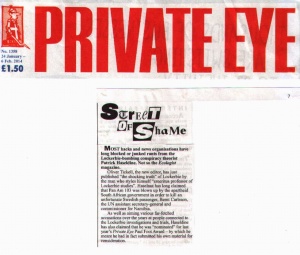
On 4 February 2014, Caroline Feraday (Mrs Mark Lewis) cited an article in the latest issue of Private Eye magazine about Patrick Haseldine's nomination for the 2013 Paul Foot Award, an extract of which reads:
- "As well as aiming various far-fetched accusations over the years at people connected to the Lockerbie investigations and trials, Haseldine has also claimed that he was 'nominated' for last year’s Private Eye Paul Foot Award – by which he meant he had in fact submitted his own material for consideration."[30]
Caroline Feraday then tweeted to Patrick Haseldine (@BerntCarlsson), as follows:
- Have you nominated yourself for 'Twat of the Year' too?[31]
Mark Lewis, having favorited his wife's tweet and retweeted it to his 3,481 Twitter followers, thoughtfully added his own tweet:
- Lockerbie: Private Eye rumbles "Haselnut" and The Ecologist:
- Why tweet as @BerntCarlsson when #Haselnut would be apt?[32]
In response to Mr and Mrs Lewis, Patrick Haseldine tweeted:
- "#TwatOfTheYear" is preferable to "#OdiousBombExpert" awarded to your dad #AlanFeraday (https://wikispooks.com/wiki/Alan_Feraday) #Lockerbie [33]
- @MarkLewisLawyer Nice nickname @BerntCarlsson remains the highest profile #Lockerbie victim (https://wikispooks.com/wiki/Alan_Feraday#Tweet_Twat) failed by #AlanFeraday[34]
See also
- Lockerbie Official Narrative
- Cameron's Report on Lockerbie Forensic Evidence
- The Framing of al-Megrahi
- The How, Why and Who of Pan Am Flight 103
External links
- "Police investigations of 'politically sensitive' or high profile crimes" Report on the Lockerbie investigation by former Lord Advocate Colin Boyd
- "The Iron Lady's Revenge"
References
- ↑ "The Forensic Files (part 1)"
- ↑ "'Gibraltar', a New Play: a Look at 'Death On The Rock' 25 Years On"
- ↑ "Introducing Allen Feraday"
- ↑ @MrStevenRaeburn
- ↑ "'Doubts' over Lockerbie evidence" BBC News (2005-08-19)
- ↑ "PQ on the Caddy Inquiry" (1996-12-09)
- ↑ "The Framing of al-Megrahi"
- ↑ "Caddy Inquiry: Forensic Explosives Laboratory"
- ↑ "Alan Feraday and the Evidence of the Lockerbie Trial"
- ↑ "McNamee's 11-year campaign for justice "
- ↑ "IRA Hyde Park bomb: John Downey denies murder"
- ↑ "John Anthony Downey in court over 1982 IRA Hyde Park bombing"
- ↑ "REVEALED: THE TOP SINN FEIN MEMBER CHARGED OVER IRA HYDE PARK BOMB MURDERS"
- ↑ "IRA bomb accused John Downey granted bail"
- ↑ Gareth Peirce's critique of Alan Feraday OBE
- ↑ "Alan Feraday and the evidence of the Lockerbie trial" Ludwig de Braekeleer, Canada Free Press Retrieved on 2009-05-14
- ↑ "Bomb expert links hotel device to Glasgow cache"
- ↑ "Outrage as Brighton bomber freed"
- ↑ "Commission refers conviction of Mr Hassan Assali to Court of Appeal" (2003-04-19)
- ↑ "IRA gang shot dead in Gibraltar"
- ↑ Leppard, David. "On the Trail of Terror: The Inside Story of the Lockerbie Investigation" London, Jonathan Cape. 1991. 221 pages.
- ↑ "Lockerbie bomb 'in suitcase'" BBC News (2000-06-15)
- ↑ "Lockerbie terror bomber's conviction thrown into doubt" Edinburgh Evening News, Lucy Christie (2005-08-19)
- ↑ "Re-Opening the Lockerbie Tragedy" TIME Laura Blue
- ↑ "Lockerbie bomber Megrahi may be allowed home" Jason Allardyce; Mark Macaskill (2009-05-10)
- ↑ "Lockerbie bomber freed from jail"
- ↑ "Lockerbie bomber Abdelbaset al-Megrahi reported dead in Libya"
- ↑ "Caroline Feraday and mum Gillian"
- ↑ "DJ Caroline Feraday's brief encounter"
- ↑ "Private Eye rumbles 'Haselnut' and The Ecologist"
- ↑ "Have you nominated yourself for 'Twat of the Year' too?"
- ↑ "Why tweet as @BerntCarlsson when #Haselnut would be apt?"
- ↑ "Odious Bomb Expert"
- ↑ "Highest profile Pan Am Flight 103 victim"
